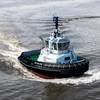Award to Restore Habitat After 1953 Sinking
State and federal trustees were awarded $16.9m for seven projects to address harm from mysterious oil leaks that killed more than 50,000 California seabirds since 1990. The projects will help species impacted by oil that leaked from the S.S. Jacob Luckenbach. The freighter sank in 1953 about 17 miles southwest of the Golden Gate Bridge, but was not identified as the source of the oil until 2002 after decades of leaking oil, especially during winter storms, causing massive injury to wildlife.
“This funding will go a long way to restore California’s seabird populations that were devastated by oil released from the Luckenbach,” said Stephen Edinger, administrator for the California Department of Fish and Game’s Office of Spill Prevention and Response. “We appreciate the hard work of our trustee agency partners in identifying and developing projects to benefit these valuable natural resources.”
To provide the greatest benefit to the injured bird species, each project will occur at the species’ breeding grounds. Four of the breeding grounds and restoration projects will be done in northern California with others for long-distance migratory seabirds in New Zealand, Baja California and British Columbia. The projects will:
• Restore high-value nesting habitat for ashy storm-petrels on the Farallon Islands;
• Reduce human disturbance at five common murre breeding colonies in California;
• Improve breeding success of common murres by reducing raven predation through land management practices at cattle ranches near Point Reyes National Seashore;
• Restore dune habitat at Point Reyes for nesting snowy plovers;
• Protect nesting shearwater colonies from depredation at Taiaroa Head, New Zealand;
• Restore and protect seabird populations on five islands along the Pacific Coast of Baja, Mexico; and
• Restore nesting habitat for ancient murrelets by eradicating non-native rats on the Queen Charlotte Islands of British Columbia, Canada.
In 2002, state and federal officials identified the Luckenbach as the source of many mystery oil spills occurring periodically during winter storms. The spills resulted in the oiling of thousands of seabirds along northern California beaches from Bodega Bay to Monterey Bay for decades. Impacted threatened or endangered species include snowy plovers, marbled murrelets and sea otters, as well as waterfowl, loons, grebes, cormorants, brown pelicans, gulls and shorebirds.
In 2002, the U.S. Coast Guard oversaw a $19-million effort to remove oil from the wreck and to seal it to prevent further oil releases.
The federal and state trustees for the injured natural resources are the U.S. Department of the Interior through the Fish and Wildlife Service and the National Park Service, the U.S. Department of Commerce through the National Oceanic and Atmospheric Administration, and the California Department of Fish and Game Office of Spill Prevention and Response. Together they form the Luckenbach Trustee Council, authorized to act on behalf of the public under State and federal law to assess and recover natural resource damages and to plan and implement actions to restore, rehabilitate, replace or acquire the equivalent of the affected natural resources injured as a result of a discharge of oil.
The award is a result of a claim filed by the trustees in 2006 for funding from the Oil Spill Liability Trust Fund. While the owners of the Luckenbach no longer exist, the Oil Spill Liability Trust Fund pays for oil spill cleanup and the restoration of impacted natural resources when there is no responsible party. The fund is sustained by fees from the oil industry and managed by the Coast Guard’s National Pollution Funds Center (NPFC).
Overall the Trustees identified 14 restoration projects, totaling more than $20 million, to address the injuries from the spills. The NPFC previously approved $2.8 million for five projects to restore seabirds and sea otters. Two other projects to benefit marbled murrelets are still under review. The previous allocation focused on restoring common murres, grebes and other seabirds in northern California, helping sea otters in Monterey Bay, and helping nesting seabirds in southwestern Alaska.










